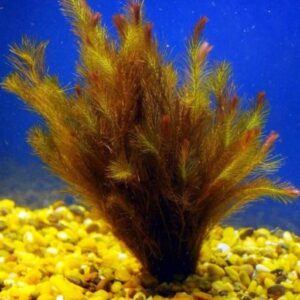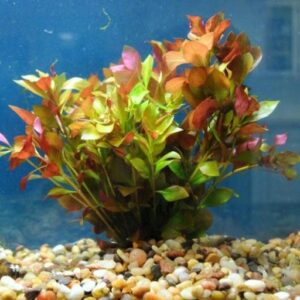Hornwort is one of the most popular aquatic plants, known for its versatility and easy maintenance. Whether you’re a beginner in the aquarium hobby or an experienced aquarist, Hornwort can be a great addition to your aquatic setup. But how do you properly care for this plant to keep it thriving?
In this article, we’ll dive deep into how to care for Hornwort, its features, and everything you need to know about keeping it healthy in your aquarium.
Table of Contents
ToggleHow to Care for Hornwort
Taking care of Hornwort is easier than you might think. This plant thrives in a variety of conditions, making it perfect for all types of aquariums. However, like any other living thing, it does have some preferences when it comes to water conditions, lighting, and general maintenance.
Basic Care Requirements
Hornwort doesn’t require special care or attention. However, it thrives best when you maintain the right water parameters and offer adequate lighting.
Ideal Water Conditions
Hornwort is very adaptable, but it prefers water temperatures between 59°F to 86°F. pH levels should be kept between 6.0 and 7.5. It can tolerate a wide range of water hardness levels, from soft to hard water.
Lighting and Placement Tips
While Hornwort can grow in low-light conditions, it thrives when exposed to moderate lighting. Direct, high-intensity lighting might cause its growth to skyrocket, so ensure the light level suits the plant’s needs.
Hornwort and Its Features
One of the most fascinating things about Hornwort is its unique structure and ability to grow quickly. Its long, thin stems are covered with tiny leaves, which makes it look feathery and delicate. Despite its soft appearance, Hornwort is a robust plant.
Growth Rate and Patterns
Hornwort is a fast grower, and under the right conditions, it can grow up to several inches in just a few weeks. This rapid growth is beneficial if you’re looking to fill up your tank quickly, but it can also become overwhelming if not properly managed.
Role in Aquarium Ecosystems
Beyond aesthetics, Hornwort plays an essential role in maintaining your aquarium’s balance. It helps absorb excess nutrients, reducing the risk of algae outbreaks. It also serves as a hiding spot for small fish and fry, offering them a safe space to escape from larger tank mates.
How to Plant Hornwort
When it comes to planting Hornwort, you have two options: floating or anchoring it into the substrate.
Floating vs. Anchored Planting
Many aquarists choose to let Hornwort float freely, as it naturally grows in this manner in the wild. However, if you prefer a more structured look, you can anchor the plant by gently burying the stems into the substrate. Just be careful, as the stems are quite delicate.
Best Practices for Planting
If you decide to anchor Hornwort, make sure the substrate is soft enough to avoid damaging the stems. You can also use plant weights to help keep it in place.
The Benefits of Hornwort in Your Aquarium
Hornwort is more than just a pretty plant—it offers several practical benefits for your tank.
Natural Filtration
Hornwort acts as a natural filter by absorbing nitrates and other harmful substances from the water, keeping your aquarium cleaner and healthier for your fish.
Algae Control
Since Hornwort competes with algae for nutrients, it helps to reduce algae growth in your tank, leaving you with clearer water.
Hiding Spots for Fish and Fry
Hornwort provides excellent hiding spots for smaller fish and fry, giving them protection from larger, more aggressive tank mates.
Common Issues with Hornwort
While Hornwort is relatively easy to care for, it’s not immune to problems.
Melting and Shedding
One common issue with Hornwort is melting, where parts of the plant begin to disintegrate. This usually happens when the plant is introduced to a new tank or if the water conditions are drastically different from what it’s used to.
Overgrowth Management
Since Hornwort grows so quickly, it can take over your tank if not trimmed regularly. Be prepared to prune it often to prevent it from crowding out other plants.
Algae Buildup
Algae can sometimes build up on the stems and leaves of Hornwort, especially in tanks with high lighting. Regular cleaning and proper maintenance can prevent this.
Hornwort Compatibility with Other Plants
If you’re considering adding Hornwort to a planted tank, it’s important to choose compatible plants.
Best Companion Plants
Plants like Java Fern, Anubias, and Cryptocoryne work well with Hornwort as they thrive under similar conditions.
Plants to Avoid with Hornwort
Avoid plants that require high levels of nutrients, as Hornwort can outcompete them and cause them to struggle.
Hornwort for Different Aquarium Types
Hornwort is versatile enough to work in various aquarium setups, from freshwater tanks to outdoor ponds.
Freshwater Aquariums
Hornwort is a favorite for freshwater tanks due to its hardy nature and ability to thrive in different water conditions.
Pond Setups
Hornwort can also be used in outdoor ponds, where it provides shelter for pond fish and helps keep the water clean by absorbing excess nutrients.
How to Prune and Trim Hornwort
Pruning Hornwort is essential to keeping it healthy and preventing it from taking over your tank.
Best Tools and Techniques
Use a pair of sharp, sterilized scissors to trim the plant. Aim to cut just above the leaf nodes to encourage new growth.
How Often to Prune
Depending on how fast your Hornwort is growing, you may need to prune it every 2-3 weeks to keep it under control.
Related products
Aquarium plants
Aquarium plants
Aquarium plants
Aquarium plants
Aquarium plants







